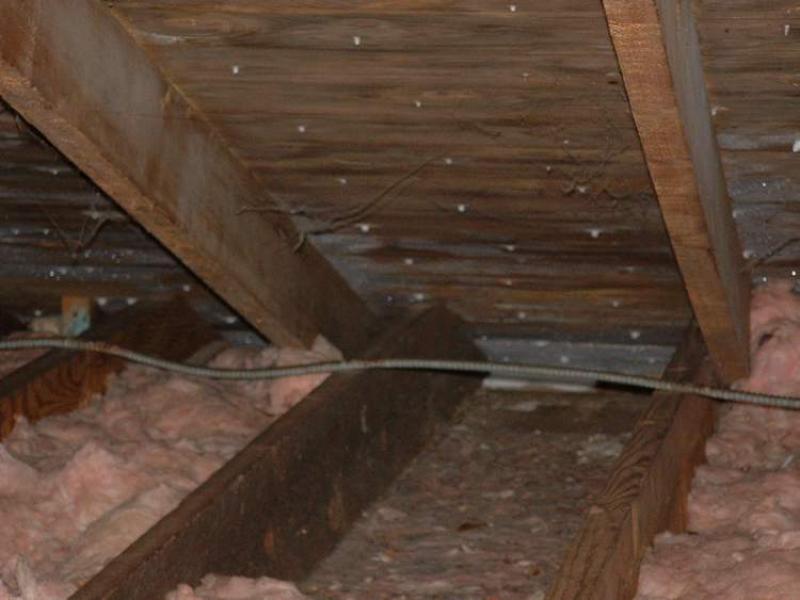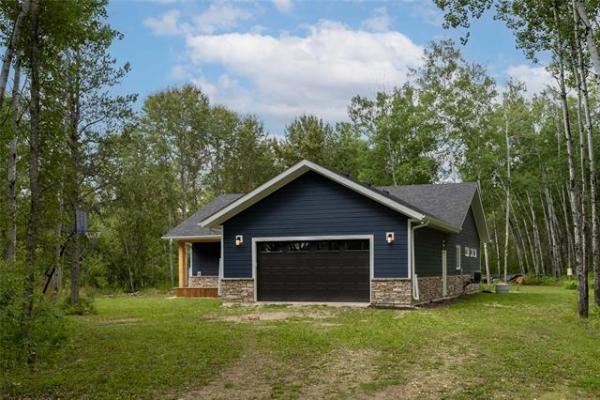QUESTION: I consider myself a fairly attentive homeowner and have noticed something in my attic that has me concerned.
We recently installed a wood-burning fireplace insert in our 1980 home, retrofitted into the brick fireplace with a stainless chimney liner installed. The chimney is two storeys high and vents a good six feet above the roof line. The chimney is in good shape, the roof is new, and the attic has 8-10 inches of batt insulation.
I re-did the roof myself and installed two of the high-stack vents near the peak. There are also vents through the siding on the gable ends and good intake at all eaves, with baffles keeping the insulation from blocking airflow.
My problem is that with the weather here at about -10C every day I noticed small icicles from the roof around the chimney where I've never known my roof to cause icicle formation. I went up in the attic to see if the eaves were blocked and they are open, but I see two or three spots of frost on the sheathing -- about the size of my hand right near the baffles located closest to the brick chimney. The nails there are icy too, but the rest of the roof sheathing and trusses look fine. I have no bathroom vents or anything bad like that sourcing moisture into the attic.
My question is is a little bit of frost normal in Canada? Several online posts, mostly from American sources, say that any frost is not normal and signals impending doom. Being an engineer, I would like to understand the realistic targets for my zone, the age of my home, etc. I wonder if I should do something. Need I tear back the insulation for a closer look, or wait until spring to investigate?
Thanks in advance.
Peter Popplewell, Ottawa
How much frost should you have in an attic? A few years ago, we had a lot of frost and a company came in and charged us $250 to spray the exhaust fan and duct to stop leakage. We still have one area in the rafters between the bathroom and a walk-in closet that has some frost. As seniors with medical conditions, we are worried about mould. Is there a reputable firm that can look at this, or is it not necessary considering our climate?
Thank you,
Susan Shallcross
ANSWER: I have included your two questions, which are only a couple of the many I have received in the last couple of years, as they are similar and will help me to answer numerous readers questions about frosty attics. As with many hidden or inconsistent problems in homes, remediation may not be critical unless the issue becomes much worse over time.
The main reason I chose both of your inquiries is that, despite different geographic regions and variables, they both ask the basic question: "How much frost is too much?"
The straight-forward answer is that a little frost seen in a Canadian attic in the dead of winter is nothing to panic about. Sticking my head into hundreds of attics every year, I see lots where there is stained, wet or slightly frosty sheathing or rafters. It's very, very common to see frost in small areas, on the roofing nails penetrating the sheathing, and in areas where air circulation may not be the best. To see this is not ideal, but it's very much expected, especially in older homes.
Even in newer homes, some frost at various times of the year is nothing to worry about. Last year, virtually every attic that I looked into for the first couple of months of winter had significant frost. This included newer homes and those with seemingly excellent ventilation and proper insulation and air/vapour barriers.
The conclusion I came to, which was confirmed by various other inspectors and building scientists I spoke to, is that it was due to unusual weather conditions. Because of the extremely wet summer and fall, combined with unusually warm fall temperatures which immediately dropped to well below freezing in late November, attics were affected. Excessive moisture underneath many roofs was due to trapped moisture from the warm, wet autumn weather. Because there was not the usual gradual cooling and drying, which is typical of a Manitoba autumn, abnormal amounts of moisture were present in attics when the weather suddenly changed. This moisture quickly condensed on the underside of many roofs and froze.
The resulting thick layer of frost remained for several weeks until the weather warmed or a reasonable layer of snow covered the roofs to provide some insulation from the very cold exterior temperatures.
This winter, warmer, dryer weather has seen the return of more normal attic conditions with significant frost seen only in problematic attics. The unusual amounts of frost last year likely melted, evaporated or escaped from attics with typical warm summer weather and passive ventilation.
I've received only a fraction of the phone calls and emails with this concern this season as compared to last year. While it's good practice to periodically peek in your attic, and do some maintenance to improve air sealing and ventilation, I would not lose any sleep if you see small amounts of frost in a few locations.
It's very likely improvements to your home, like installing and using a wood-burning device, have allowed additional heat and moist air to leak into isolated areas of your attics. Also, having a bathroom exhaust fan improperly installed, without proper air sealing, will lead to frost build-up and leakage. The difference between these two examples is that the fan issue needs to be dealt with, as you have done, but the others may not
In short, if you see moderate to large areas of very thick frost in your attic, then action may be needed. Otherwise, a few small spots near an old chimney or small gaps above interior partition walls is nothing to worry about.
Ari Marantz is the owner of Trained Eye Home Inspection Ltd. and the president of the Canadian Association of Home & Property Inspectors--Manitoba (www.cahpi.mb.ca). Questions can be e-mailed to the address below. Ari can be reached at (204) 291-5358 or check out his website at www.trainedeye.ca.
trainedeye@iname.com




